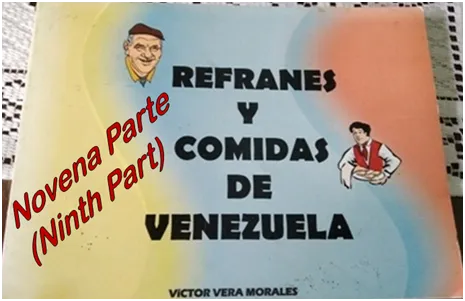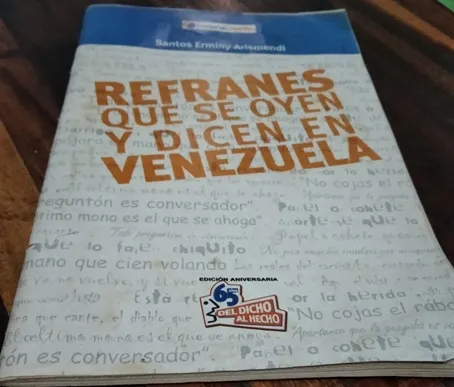Siguiendo con los refranes de mi país, Venezuela, considero es ideal compartirlos en esta comunidad de Hive Cross Culture!, que es tan chévere, interesante y diversa. Hoy día les traigo la novena parte de este seriado “Cinco sabios refranes venezolanos”, la cual recopila los dichos más comunes y de uso diario en las distintas regiones del país. Como de costumbre, al final del post pueden encontrar los enlaces para leer las ocho primeras entregas. Y así como he hecho últimamente, hoy utilizaré el libro “Refranes que se oyen y dicen en Venezuela”, cuyo autor es Santos Erminy Arismendi, libro publicado por la Cadena Capriles en el año 2006, el cual venía encartado gratis en el periódico “Últimas Noticias” y; obviamente, los análisis y comentarios son hechos por mí en su totalidad.


Las curiaras son embarcaciones de madera, muy largas y delgadas, tipo canoas, que se utilizan fundamentalmente para navegar el Río Orinoco y sus afluentes. Por su parte, un raudal es el tramo en el cual el río se estrecha; y por ende, aumenta la velocidad y fuerza con la cual corre el agua por él. Cuando una curiara navega en un raudal, por lo general es zarandeada de un lado para otro por la fuerza del agua. Entonces, este dicho se utiliza para hacer referencia a aquella persona que no se está quieta en un solo sitio, que se mueve de un lado para otro, que no se establece en un sitio o trabajo definido, generalmente por falta de aplomo.
Este refrán se utiliza a que es imposible cambiar algo que por naturaleza es así, fundamentalmente cuando se hace referencia a defectos de carácter. Por eso la comparación, de que el que nace barrigón o con la panza muy grande, difícilmente se le rebajará o aplanará, aún cuando le pongan una faja desde pequeño.
Cuando se habla del palo, se hace referencia al árbol, específicamente a su madera, la cual debe tener ciertas condiciones para poder ser utilizada en la elaboración de utensilios como la cuchara, la paleta, bateas, entre otros. Este refrán indica, que la situación no está buena, que no están las circunstancias adecuadas para hacer algo, vivir bien, etc.
Gimnasia y Magnesia en Español, son dos palabras que se enuncian y se escriben de forma, muy similar, pero significan cosas muy diferentes; de allí que se utilice este refrán para advertir a alguien que no se confunda, que no mezcle las cosas.
Generalmente, cuando se enciende una hoguera, al apagarla quedan las cenizas de la madera que se ha quemado. Así que ese refrán se utiliza para hacer referencia a que luego de que finaliza una relación amorosa, aún pueden quedar ciertos sentimientos vigentes entre los que un día fueron pareja.

<div class="text-justify> Continuing with the sayings of my country, Venezuela, I consider it ideal to share them in this Hive Cross Culture! community, which is so cool, interesting and diverse. Today I bring you the ninth part of this series "Five wise Venezuelan sayings", which compiles the most common sayings and daily use in the different regions of the country. As usual, at the end of the post you can find the links to read the first eight installments. And just as I have done lately, today I will use the book "Sayings that are heard and said in Venezuela", whose author is Santos Erminy Arismendi, a book published by Cadena Capriles in 2006, which was inserted for free in the newspaper "Últimas News ”and; obviously, the analysis and comments are made by me in their entirety.


Curiaras are wooden boats, very long and slender, like canoes, which are used mainly to navigate the Orinoco River and its tributaries. For its part, a stream is the section where the river narrows; and therefore, the speed and force with which the water runs through it increases. When a curiara navigates a stream, it is usually struck from side to side by the force of the water. So, this saying is used to refer to a person who does not stay still in one place, who moves from one place to another, who does not settle in a place or job, generally due to lack of poise.
This saying is used to say that it is impossible to change something that by nature is so, fundamentally when it refers to character defects. That is why the comparison, that the one born with a bulging or very large belly, will hardly be lowered or flattened, even when he puts on the sash since he was a child.
When talking about the stick, it refers to the tree, specifically its wood, which must have certain conditions to be used in the elaboration of utensils such as the spoon, the palette, trays, among others. This saying indicates that the situation is not good, that the right circumstances do not exist to do something, live well, etc.
Gymnastics and Magnesia in Spanish are two words that are enunciated and written in a very similar way, but they mean very different things; hence this saying is used to warn someone not to get confused, not to mix things up.
Generally, when a bonfire is lit, when it is extinguished, the ashes of the wood that has been burned remain. So that saying is used to refer to the fact that after a love relationship ends, there may still be certain current feelings between those who were once a couple.

Dear readers, below I place the links of the first eight posts, in case you want to read them:
*Víctor Vera Morales. (Agosto 2004). Refranes y Comidas de Venezuela. Editado por el Instituto Municipal de Publicaciones de la Alcaldía de Caracas.
*Santos Erminy Arismendi. (2006). Refranes que se oyen y dicen en Venezuela. Cadena Capriles, Caracas. Venezuela.
- Fotos de mi autoría, tomada con un teléfono REDMI 8A, intervenida con WordArt / Photos of my authorship, taken with a REDMI 8A telephone, intervened with WordArt.
- Los diseños incluidos en esta publicación, han sido elaborados por mi persona con la aplicación CANVA / The designs included in this publication has been made by me with the CANVA application.
In the event that it is required to use the content or images of this post and my other publications, I would be grateful if my authorship (Fabiola Martínez) was made and the corresponding link was cited. Thank you.

 CommunityIIDiscord
CommunityIIDiscord